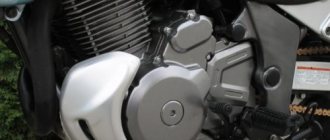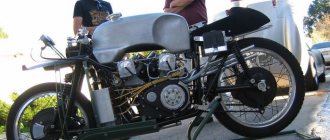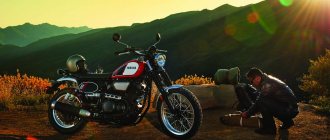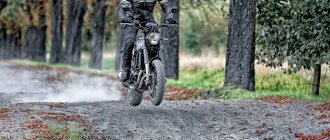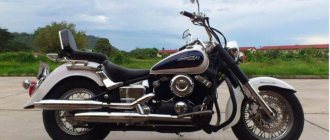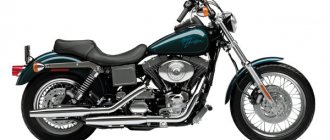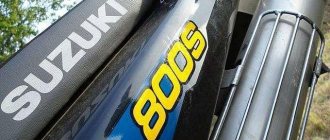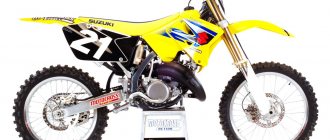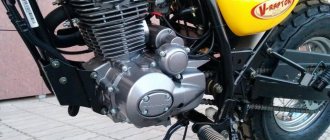Review of the Suzuki XF 650 Freewind motorcycle
This is my second year riding Freewind. It suits me in almost all respects except weight, and only if it’s in the forest. Sometimes you have to lift it, it’s nothing out of the blue, but once I lifted it on a hill when the wheels were higher than the seat, and until I turned the recumbent almost 180 degrees, I couldn’t lift it. And there was a rise and moss, so the steering wheel worked like a plow, plowing. For unpaved and sandy parking lots, without a central stand, you have to carry some kind of padding for the side stand. A certain inconvenience on forest paths is caused by the fact that the plastic covers the front wheel, but you quickly get used to it and did not cause any special problems. The exhaust pipe near the cylinder itself gets very hot. A couple of times it happened that I pulled out a charred pine stick from there. The smell of burnt pine needles warns of this, and with last year’s sushi in the forest and meadow you need to be careful. Falling into dry grass, or even just driving through tall, dry grass can cause a fire. But this is of course at low speed. On a stationary motorcycle, even in slight frost, when warming up on suction, the pipe at the outlet of the cylinder in the dark of the garage is well red.
At a speed of about 100 km/h, it consumes gasoline not much more than the YBR 125, which under me (95 kg in armor) barely reached this speed, I had to bend down, and worked beyond the peak of power and efficiency. I have never pierced the pendants yet. In stretches at low speed, due to sufficient torque, the engine operates steadily, without jerking, and the motorcycle is stable. Of the 650, it suits me, as I know of only three types of enduro, in which the seat height is not higher than 800mm BMW F650 GS, Aprilia Pegaso Strada, Suzuki XF 650 Freewind.
This year I closed my second season on Freewind. I'm not going to change it. It suits me in terms of saddle height - 800mm - two feet are completely on the ground, and relatively light - dry weight 162 kg. But it's still hard to lift. The absence of a central step (not in stock) forces you to choose a place to stop in the forest or in the field. I carry a piece of iron with me under my side paw. I don’t know why, but after it lies on its side, and this happens in the forest, it won’t start for 10–15 minutes. There is no Kickstarter, so you can run out of battery and it’s not inspiring on the sand. When falling at low speed on the ground, and I only had these, there was no damage. The front fairing blocks the view of the wheel, but this no longer causes inconvenience on forest and meadow paths. I find it very stable at low speeds. On dirt roads you can drive almost at walking speed without putting your feet down; on sand you need to either play with the clutch or go a little faster. It’s more stable on sand than the YBR 125, but on the IZH-56, as I remember, I felt more confident.
The tank fairing protects your legs well from wind and rain. The stock windshield is more effective at speeds of 90 – 100 km/h and above. But I didn’t go more than 140. And even then only for a short time, for overtaking. Considering my weight in armor is under 100 kg, up to 140 km/h, I think that its dynamics are sufficient. To overtake those moving at a speed of 90 - 100 km/h, I did not shift to a lower gear - there was enough traction even in fifth.
I pressed the fingers on my left hand with the clutch lever a couple of times. It is easily squeezed out with two fingers and with the other two. As a resident of Kyiv (traffic jams, toffee on ups and downs), and a lover of forest and meadow rides, stability and smoothness at creeping speed are of great importance to me. I will say this, I was less comfortable on the YBR 125 than on the Freewind, although it is heavier and a little higher. More torque at the bottom for my weight makes the Freewind ride more stable at low speeds. Suspension. I've never punched it yet. Of course, I don’t jump off springboards and don’t drive over bumps, but I used the YBR 125 regularly both on Pobeda Avenue and on the expressway along the light rail, especially on bridges and when crossing tram tracks. The fork is 43 mm, there is a fork. Over the two years of my not very intensive use, I have driven about 7-8 thousand km. There was not a single breakdown. Now its mileage is almost 30,000 km. Gasoline consumption is about 4 liters under me, at a speed of 90 km/h on the highway. On YBR 125 at the same speed it was not much less. I filled the oil at the beginning of the last season and ran it until the end of the current one without topping it up. Now, at minus 8, it started normally with the second press on the starter. There are quite a few different videos about Freewind on You Tube. There is also traditional wheelie riding, like one pole and the Russians' trip through Altai. The latter shows the capabilities of Freewind very well.
I've been riding this machine since August 2011. Traveled more than 5000 km. today (I travel 100 km round trip to work every day, + traveled to Nizhny Novgorod and around the region (NN) last year). On the technical side: before the 2012 season, the gaskets were replaced (oil was leaking from under the cylinder block), piston rings, filters and other consumables. The point is that the car's mileage has exceeded 40 thousand miles! The master said that he would continue to walk for a long time. Pah-pah-pah, I really hope so.
According to consumer qualities. Yes, there are disadvantages: (i) for long-range cruising it is too small - 110-115 without vibration. Then the vibration starts, not to say that it’s kick-ass, but after 3 hours of travel, I personally tried to drive at the specified speed limit. (ii) the engine starts to figure something out from 3 thousand revolutions, and from 4 thousand it finally drives cool, but (iii) its appetite at such speeds is not small (I drive through traffic jams to work - 700-800 rubles. /week for gasoline, i.e. more than 5 liters per hundred, despite the fact that in long-distance driving this consumption will not decrease). In terms of consumption, this is my second motorcycle (the first was a Java 350) - so, in fact, there is nothing to compare with :) probably some BMW 1200 GS eats the whole ten.
Now about the benefits. The most important thing for me is, after all, its versatility. It's an excellent ride around the city, and on the highway (I'm not a fan of driving - 90 km/h is enough for me), and most importantly - I wanted to - I could turn anywhere. I don’t like hard off-road driving, but driving through the forest, getting to places where only cyclists and pedestrians can pass - yes. Of course, if funds allowed, I would have 3 motorcycles: for the highway (like the BMW 1200 RT), for the city (like Van-Van or YBR) and for such country tourism as they say (like the BMW 800 GS). In the meantime, you need all three functions in the 1st - it turns out Freewind :)
Review of the Suzuki XF 650 Freewind motorcycle
This is my second year riding Freewind. It suits me in almost all respects except weight, and only if it’s in the forest. Sometimes you have to lift it, it’s nothing out of the blue, but once I lifted it on a hill when the wheels were higher than the seat, and until I turned the recumbent almost 180 degrees, I couldn’t lift it. And there was a rise and moss, so the steering wheel worked like a plow, plowing. For unpaved and sandy parking lots, without a central stand, you have to carry some kind of padding for the side stand. A certain inconvenience on forest paths is caused by the fact that the plastic covers the front wheel, but you quickly get used to it and did not cause any special problems. The exhaust pipe near the cylinder itself gets very hot. A couple of times it happened that I pulled out a charred pine stick from there. The smell of burnt pine needles warns of this, and with last year’s sushi in the forest and meadow you need to be careful. Falling into dry grass, or even just driving through tall, dry grass can cause a fire. But this is of course at low speed. On a stationary motorcycle, even in slight frost, when warming up on suction, the pipe at the outlet of the cylinder in the dark of the garage is well red.
At a speed of about 100 km/h, it consumes gasoline not much more than the Yamaha YBR 125 , which under me (95 kg in armor) could barely pick up this speed, I had to bend down, and worked beyond the peak of power and efficiency. I have never pierced the pendants yet. In stretches at low speed, due to sufficient torque, the engine operates steadily, without jerking, and the motorcycle is stable. Of the 650, it suits me, as I know of only three types of enduro, in which the seat height is not higher than 800mm BMW F650 GS , Aprilia Pegaso Strada , Suzuki XF 650 Freewind .
This year I closed my second season on Freewind. I'm not going to change it. It suits me in terms of saddle height - 800mm - two feet are completely on the ground, and relatively light - dry weight 162 kg. But it's still hard to lift. The absence of a central step (not in stock) forces you to choose a place to stop in the forest or in the field. I carry a piece of iron with me under my side paw. I don’t know why, but after it lies on its side, and this happens in the forest, it won’t start for 10–15 minutes. There is no Kickstarter, so you can run out of battery and it’s not inspiring on the sand. When falling at low speed on the ground, and I only had these, there was no damage. The front fairing blocks the view of the wheel, but this no longer causes inconvenience on forest and meadow paths. I find it very stable at low speeds. On dirt roads you can drive almost at walking speed without putting your feet down; on sand you need to either play with the clutch or go a little faster. It’s more stable on sand than the Yamaha YBR 125 , but on the IZH-56 , as I remember, I felt more confident.
The tank fairing protects your legs well from wind and rain. The stock windshield is more effective at speeds of 90 – 100 km/h and above. But I didn’t go more than 140. And even then only for a short time, for overtaking. Considering my weight in armor is under 100 kg, up to 140 km/h, I think that its dynamics are sufficient. To overtake those moving at a speed of 90 - 100 km/h, I did not shift to a lower gear - there was enough traction even in fifth.
I pressed the fingers on my left hand with the clutch lever a couple of times. It is easily squeezed out with two fingers and with the other two. As a resident of Kyiv (traffic jams, toffee on ups and downs), and a lover of forest and meadow rides, stability and smoothness at creeping speed are of great importance to me. I will say this, I was less comfortable the Yamaha YBR 125 More torque at the bottom for my weight makes the Freewind ride more stable at low speeds. Suspension. I've never punched it yet. Of course, I don’t jump off springboards or ride over bumps, but on the Yamaha YBR 125 I regularly hit it both on Pobeda Avenue and on the high-speed highway along the high-speed tram, especially on bridges and when crossing tram tracks. The fork is 43 mm, there is a fork. Over the two years of my not very intensive use, I have driven about 7-8 thousand km. There was not a single breakdown. Now its mileage is almost 30,000 km. Gasoline consumption is about 4 liters under me, at a speed of 90 km/h on the highway. On the Yamaha YBR 125 at the same speed it was not much less. I filled the oil at the beginning of the last season and ran it until the end of the current one without topping it up. Now, at minus 8, it started normally with the second press on the starter. There are quite a few different videos about Freewind on You Tube. There is also traditional wheelie riding, like one pole and the Russians' trip through Altai. The latter shows the capabilities of Freewind very well.
I've been riding this machine since August 2011. Traveled more than 5000 km. today (I travel 100 km round trip to work every day, + traveled to Nizhny Novgorod and around the region (NN) last year). On the technical side: before the 2012 season, the gaskets were replaced (oil was leaking from under the cylinder block), piston rings, filters and other consumables. The point is that the car's mileage has exceeded 40 thousand miles! The master said that he would continue to walk for a long time. Pah-pah-pah, I really hope so.
According to consumer qualities. Yes, there are disadvantages: (i) for long-range cruising it is too small - 110-115 without vibration. Then the vibration starts, not to say that it’s kick-ass, but after 3 hours of travel, I personally tried to drive at the specified speed limit. (ii) the engine starts to figure something out from 3 thousand revolutions, and from 4 thousand it finally drives cool, but (iii) its appetite at such speeds is not small (I drive through traffic jams to work - 700-800 rubles. /week for gasoline, i.e. more than 5 liters per hundred, despite the fact that in long-distance driving this consumption will not decrease). In terms of consumption, this is my second motorcycle (the first was a Java 350) - so, in fact, there is nothing to compare with :) probably some BMW 1200 GS eats the whole ten.
Now about the benefits. The most important thing for me is, after all, its versatility. It's an excellent ride around the city, and on the highway (I'm not a fan of driving - 90 km/h is enough for me), and most importantly - I wanted to - I could turn anywhere. I don’t like hard off-road driving, but driving through the forest, getting to places where only cyclists and pedestrians can pass - yes. Of course, if funds allowed, I would have 3 motorcycles: for the highway (like the BMW 1200 RT ), for the city (like Van-Van or YBR) and for such country tourism as they say (like the BMW 800 GS ). In the meantime, you need all three functions in the 1st - it turns out Freewind :)
Go to the Suzuki XF 650 Freewind
Check out the test drives:
- Suzuki XF650 Freewind: Test drive
